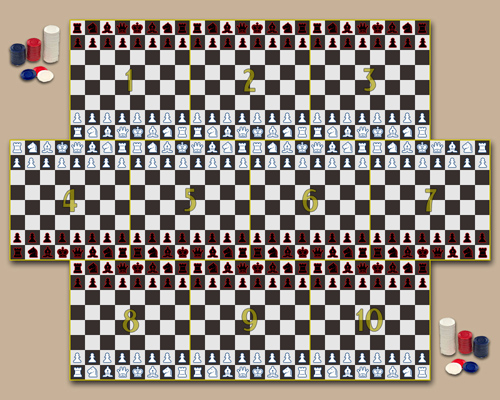Monster Bluff Chess
Entrant for The Chess Variant Pages’ 10th Anniversary Competition

Equipment
- Ten cheap chess sets, all alike;
- A good supply of poker chips or other chips that fit on the squares of the chessboards;
- Duct tape;
- Two small, shiny star stickers.
Setup
Arrange the chess sets in a single grid, as shown in the picture. Duct tape comes in handy for keeping them together. One king of each color is marked on the bottom with a sticker—this will be the True King you have to capture to win. The unmarked kings or princes are just there to sow confusion; during setup, keep the location of your True King secret from your opponent.Place the pieces on the boards as shown. On the outside boards this is standard placement; on the inside boards 4--7, the lineup is reversed to keep queens on color.
Play
Standard FIDE rules apply to chess piece moves, including capture en passant. Extra-long rook, bishop, and queen moves are of course allowed, and so is extra-far castling (e.g. 8e1, 10a1 → 9c1, 9b1). However, pawns promote after moving six ranks forward, just as they do on a single 8×8 board.The True Kings and princes all move just like FIDE kings but are not treated as royal. Check and mate are not applicable here, for all that you might enjoy declaring them; its capture (and inspection of his bottom for the birthmark, ha ha) that matters.
After both players have achieved a pawn promotion, the chips come into play. Either player may put chips on any empty space, or add to a previous stack of chips, as his turn. Either player may pick up a stack of chips but only by capturing them as if they were an enemy chess piece. With these bribes you attempt to weaken the opponents play (I prefer white 5¢, red 10¢, blue 25¢ with possibly green for 50¢; adjust to your own taste). Chips once placed do not move, except being taken off the board when captured.
Stacks of lower-valued chips (offers) do not impede chess piece movement. Rooks, bishops, and queens can slide right over them, and pawns may move straight onto themwithout taking the chips, of course. The highest-valued chips (blue, or blue & green, say) are obstacles to movement (demands), treated by both sides as immobile enemy pieces in their own right. Sliding pieces stop for them; they block a pawns forward steps. They must be taken or worked around. So, for example, they may interpose to prevent capture of a prince.
If the game lasts long enough that one player is reduced to a single prince, his True King is known by elimination and no more chips may be placed by either player.
Capture of a True King wins the game, and the winner takes all chips remaining on the board. It is not necessarily the case that the winner will end up with the most chips.
Variations
Using sand timers or some other device to limit the length of a turn could be helpful in completing chess's transition to a party game.
A smaller version—with only four boards, say—might be useful in getting the feel of things. For those of us used to abstract games, hunting for hidden information (and being paid not to hunt too well) comes as a new and very different set of challenges.
But for that matter, nowhere in the rules does it say you have to place any of the chips! If a very long round of Big Board chess with a Surprise Ending is more to your liking, go right ahead.
Written by Dale Holmes. Webpage made: May 7, 2005.